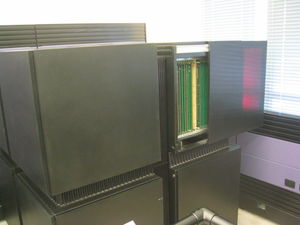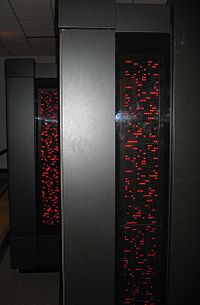- Connection Machine
-
 Thinking Machines CM-1 at the Computer History Museum in Mountain View. One of the face plates has been partially removed to show the circuit boards inside.
Thinking Machines CM-1 at the Computer History Museum in Mountain View. One of the face plates has been partially removed to show the circuit boards inside.
The Connection Machine was a series of supercomputers that grew out of Danny Hillis' research in the early 1980s at MIT on alternatives to the traditional von Neumann architecture of computation. The Connection Machine was originally intended for applications in artificial intelligence and symbolic processing, but later versions found greater success in the field of computational science.
Contents
Basis
Danny Hillis' original thesis paper on which the CM-1 Connection Machine was based is The Connection Machine (MIT Press Series in Artificial Intelligence) (ISBN 0-262-08157-1). The title is out of print as of 2005. The book provides an overview of the philosophy, architecture and software for the Connection Machine, including data routing between CPU nodes, memory handling, Lisp programming for parallel machines, etc.
History
Danny Hillis and Sheryl Handler founded Thinking Machines in Waltham, Massachusetts (it was later moved to Cambridge, Massachusetts) in 1983 and assembled a team to develop the CM-1 Connection Machine. This was a "massively parallel" hypercubic arrangement of thousands of microprocessors, each with its own 4 kbits of RAM, which together executed in a SIMD fashion. The CM-1, depending on the configuration, had as many as 65,536 processors. The individual processors were extremely simple, processing one bit at a time.
The CM-1 and CM-2 took the form of a cube 1.5 meters on a side, divided equally into eight smaller cubes. Each sub-cube contained 16 printed circuit boards and a main processor called a sequencer. Each printed circuit board contained 32 chips. Each chip contained a communication channel called a router, 16 processors, 16 RAMs. The CM-1 as a whole had a hypercubic routing network, a main RAM, and an input/output processor. It was connected to a switching device called a nexus.
In order to improve its commercial viability, the CM-2, launched in 1987, added Weitek 3132 floating-point numeric co-processors and more RAM to the system. 32 of the original one-bit processors shared each numeric processor. The CM-2 could be configured with up to 512 MB of RAM, and a RAID hard disk array, called a DataVault, of up to 25 GB.
Two later variants of the CM-2 were also produced, the smaller CM-2a with either 4096 or 8192 single-bit processors, and the faster CM-200.
 The light panels of FROSTBURG, a CM-5, on display at the National Cryptologic Museum. The panels were used to check the usage of the processing nodes, and to run diagnostics.
The light panels of FROSTBURG, a CM-5, on display at the National Cryptologic Museum. The panels were used to check the usage of the processing nodes, and to run diagnostics.
Due to its origins in AI research, the software for the CM-1/2/200 single-bit processor was influenced by the Lisp programming language and a version of Common Lisp, *Lisp (spoken: "Star-Lisp"), was implemented on the CM-1. Other early languages included Karl Sims' IK and Cliff Lasser's URDU. Much system utility software for the CM-1/2 was written in *Lisp.
With the CM-5, announced in 1991, Thinking Machines switched from the CM-2's hypercubic architecture of simple processors to an entirely new MIMD architecture based on a fat tree network of SPARC RISC processors. The later CM-5E replaced the SPARC processors with faster SuperSPARCs.
Visual Design
Connection Machines were noted for their (intentionally) striking visual design. The CM-1 and CM-2 design teams were led by Tamiko Thiel.[1] The physical form of the CM-1, CM-2, and CM-200 chassis was a cube-of-cubes, referencing the machine's internal 12-dimensional hypercube network, with the red blinking LEDs of the processor status lights visible through the doors of each cube.
The CM-5, in plain view, had a "staircase"-like shape, and also had large panels of red blinking LEDs. Perhaps because of its design, a CM-5 was featured in the movie Jurassic Park in the control room for the island (instead of a Cray X-MP supercomputer as in the novel). Prominent sculptor/architect Maya Lin contributed to the CM-5 design.
See also
- ICL DAP
- Goodyear MPP
- Parallel computing
- FROSTBURG — a CM-5 used by the NSA
- David E. Shaw's NON-VON machine, which preceded the Connection machine slightly.
- MasPar
References
- ^ DesignIssues, (Vol. 10, No. 1, Spring 1994) ISSN-0747-9360 MIT Press, Cambridge, MA.
Further reading
- Hillis, D. 1982 "New Computer Architectures and Their Relationship to Physics or Why CS is No Good", Int J. Theoretical Physics 21 (3/4) 255-262.
- Lewis W. Tucker, George G. Robertson, "Architecture and Applications of the Connection Machine," Computer, vol. 21, no. 8, pp. 26–38, August, 1988.
- Arthur Trew and Greg Wilson (eds.) (1991). Past, Present, Parallel: A Survey of Available Parallel Computing Systems. New York: Springer-Verlag. ISBN 0-387-19664-1.
- W. Daniel Hillis and Lewis W. Tucker. The CM-5 Connection Machine: A Scalable Supercomputer. In Communications of the ACM, Vol. 36, No. 11 (November 1993).
External links
Categories:- Supercomputers
- Parallel computing
- Massively parallel computers
Wikimedia Foundation. 2010.
